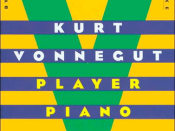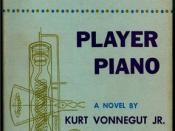Evaluate the effectiveness of diction as an adjunct to meaning in John Updike's 'Player Piano'.
In 'Player Piano', John Updike uses personification to give life to a 'unhuman' piano. By using diction to communicate his ideas, he effectively allows the reader to explore the psyche of a 'Player Piano'. In the first couple lines of the poem, assonance and consonance are present. In line one, these musical devices dominate the sentence as there is a repetition of the 'ick' sound in 'stick', 'click', and 'snicker' suggesting to the reader the sharpness of the piano, also reminding readers of the constant clicking sound found in mechanical devices. The harsh 'k' sounds of the second line in 'chuckling', 'knuckle', and 'key' suggest the abrupt sound of air passing through the paper roll of a player piano. In the next line, the word flicker is a phonetic intensive, closely associated with word 'flame'.
Since the 'flame' is a symbol of life and light, it gives the reader a feeling that the piano is alive, further adding to the effect of personification in this poem. In the last line of the first stanza, there is consonance in 'these', 'keys', and 'melodies'. The repeat of the smooth 's' sound in these three consecutive words evokes a feeling of rhythm or harmony - pleasant sounds from the player piano.
The next stanza starts with an internal rhyme: 'My paper can caper'. The simple rhyme suggests that the paper can leap and jump about like a child. The connotation of the word 'abandon' adds to this suggestion of unrestrained movement or activity. The words 'dint' and 'din' are alliterative, and the suggestion is that the 'din' of the piano broadcasts its sound far and wide. In line three of stanza...


